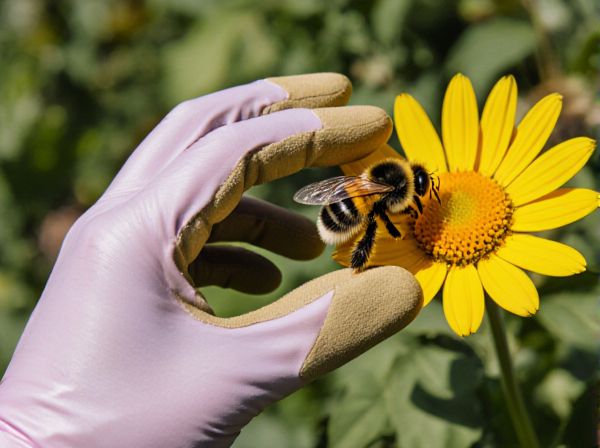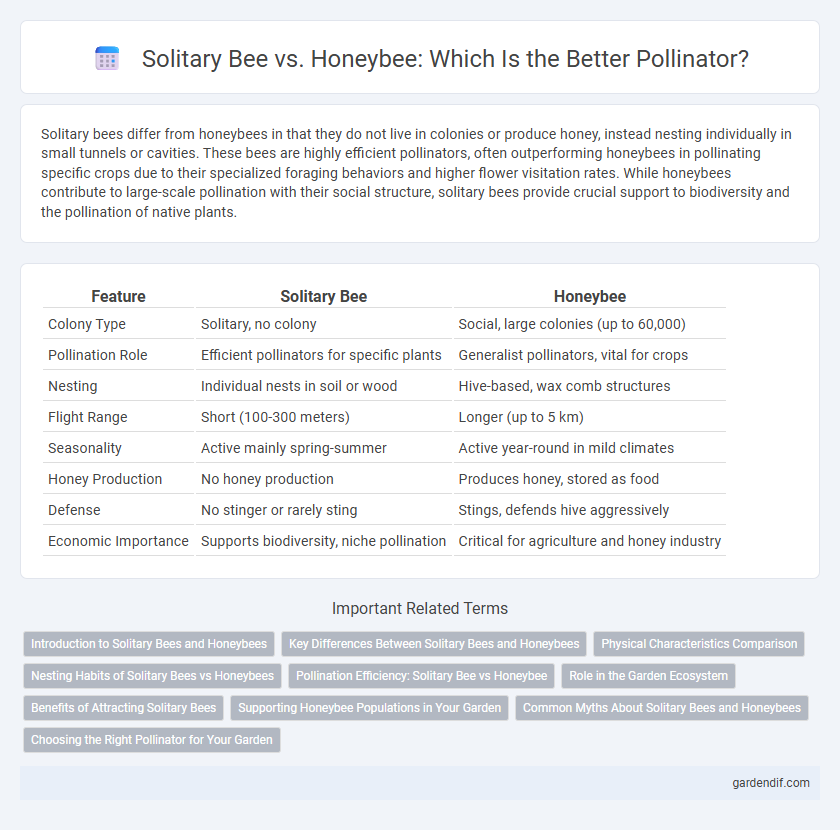
Solitary Bee vs Honeybee Illustration
Solitary bees differ from honeybees in that they do not live in colonies or produce honey, instead nesting individually in small tunnels or cavities. These bees are highly efficient pollinators, often outperforming honeybees in pollinating specific crops due to their specialized foraging behaviors and higher flower visitation rates. While honeybees contribute to large-scale pollination with their social structure, solitary bees provide crucial support to biodiversity and the pollination of native plants.
Table of Comparison
| Feature | Solitary Bee | Honeybee |
|---|---|---|
| Colony Type | Solitary, no colony | Social, large colonies (up to 60,000) |
| Pollination Role | Efficient pollinators for specific plants | Generalist pollinators, vital for crops |
| Nesting | Individual nests in soil or wood | Hive-based, wax comb structures |
| Flight Range | Short (100-300 meters) | Longer (up to 5 km) |
| Seasonality | Active mainly spring-summer | Active year-round in mild climates |
| Honey Production | No honey production | Produces honey, stored as food |
| Defense | No stinger or rarely sting | Stings, defends hive aggressively |
| Economic Importance | Supports biodiversity, niche pollination | Critical for agriculture and honey industry |
Introduction to Solitary Bees and Honeybees
Solitary bees, comprising over 20,000 species globally, are essential pollinators that operate independently, unlike honeybees which live in large colonies of up to 50,000 individuals. Honeybees (Apis mellifera) are known for their complex social structure and production of honey, playing a critical role in commercial pollination of crops like almond and apple orchards. Both solitary bees and honeybees contribute significantly to biodiversity and agricultural productivity through their unique pollination behaviors.
Key Differences Between Solitary Bees and Honeybees
Solitary bees differ from honeybees primarily in their nesting behavior, as solitary bees build individual nests rather than living in large, organized colonies. Honeybees are social insects that produce and store honey in hives, while solitary bees do not create honey and rely on individual provisioning for their offspring. The foraging habits also vary, with honeybees covering larger areas and communicating food sources through waggle dances, whereas solitary bees tend to forage closer to their nests and do not perform such complex communication.
Physical Characteristics Comparison
Solitary bees are generally smaller and less hairy than honeybees, with diverse body shapes varying by species, whereas honeybees have a uniform, robust body covered in dense hairs for pollen collection. Solitary bees often have longer antennae and less pronounced coloration compared to the golden-brown and black stripes characteristic of honeybees. The wings of solitary bees are typically narrower and more translucent, contrasting with the broader, more opaque wings of honeybees adapted for efficient flight in large colonies.
Nesting Habits of Solitary Bees vs Honeybees
Solitary bees build individual nests in natural cavities, soil, or wood tunnels, creating separate brood cells for each offspring, unlike honeybees that live in large, organized colonies with a communal hive structure. Honeybee nests contain a complex arrangement of wax combs used for brood rearing and honey storage, supported by a social system of workers, drones, and a queen. Solitary bee nests are typically less conspicuous and do not produce honey, emphasizing independent reproduction and simpler nest construction.
Pollination Efficiency: Solitary Bee vs Honeybee
Solitary bees demonstrate higher pollination efficiency than honeybees due to their foraging behavior and flower constancy, often visiting more flowers per foraging trip. Honeybees contribute significantly to pollination through large colony sizes and collective foraging but may exhibit generalized flower preferences, reducing individual pollination precision. Studies indicate solitary bees can increase crop yield by more effectively transferring pollen, making them vital pollinators for diverse agricultural ecosystems.
Role in the Garden Ecosystem
Solitary bees excel in pollinating a diverse range of garden plants by visiting more flowers per minute, enhancing fruit and seed production. Honeybees contribute through their large colony sizes, efficiently pollinating crops and supporting overall biodiversity. Both play critical roles in maintaining healthy garden ecosystems by ensuring plant reproduction and promoting ecological balance.
Benefits of Attracting Solitary Bees
Attracting solitary bees enhances pollination efficiency as they specialize in diverse flowering plants, increasing crop yields and garden biodiversity. Unlike honeybees, solitary bees are less prone to disease transmission, reducing risks to pollinator populations and supporting ecological balance. Their activity during cooler and wetter conditions extends pollination periods, benefiting early and late-blooming plants crucial for ecosystem resilience.
Supporting Honeybee Populations in Your Garden
To support honeybee populations in your garden, plant a diverse array of nectar and pollen-rich flowers such as lavender, sunflowers, and clover, which provide essential nutrients for honeybee colonies. Create protected habitats by leaving areas of bare soil and installing bee hotels to accommodate solitary bee nesting while enhancing overall pollinator diversity. Avoid using pesticides and provide fresh water sources to maintain healthy, thriving honeybee and solitary bee populations essential for effective pollination.
Common Myths About Solitary Bees and Honeybees
Solitary bees are often mistaken for less effective pollinators compared to honeybees, but research shows they are highly efficient, with some species pollinating specific crops better than honeybees. Honeybees are incorrectly believed to be the only valuable pollinators, ignoring the diverse ecosystem services provided by solitary bees such as mason bees and leafcutter bees. Common myths also exaggerate solitary bees' aggressiveness, while in reality, they are non-aggressive and rarely sting, unlike honeybees which defend the hive more aggressively.
Choosing the Right Pollinator for Your Garden
Solitary bees, such as mason bees, are highly efficient pollinators that thrive in small garden spaces and require minimal maintenance compared to honeybees. Honeybees excel at large-scale pollination and honey production but need extensive hives and management to flourish. Selecting solitary bees supports biodiversity and enhances pollination of native plants, while honeybees are ideal for crop pollination in agricultural settings.
Solitary Bee vs Honeybee Infographic

 gardendif.com
gardendif.com